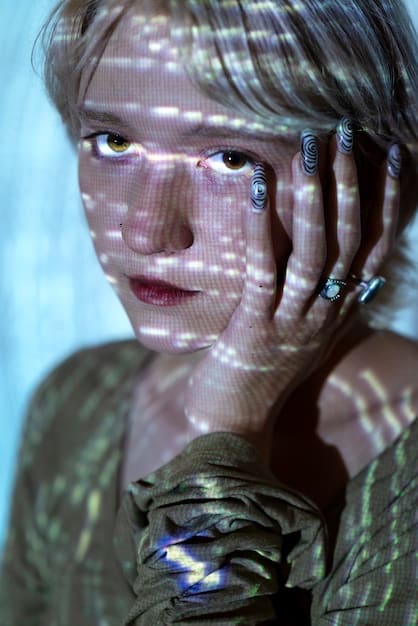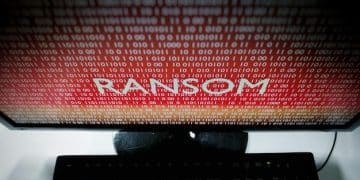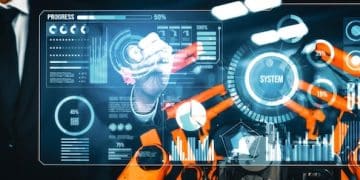Deepfakes: Spot the Fake & Protect Yourself from Growing Threats

Deepfakes, AI-manipulated videos and images, present a growing threat by spreading misinformation and causing reputational damage; learning to identify them and implementing protective measures is crucial in today’s digital landscape.
The digital age has ushered in incredible advancements, but alongside them, sophisticated threats like deepfakes have emerged. The Growing Threat of Deepfakes: How to Spot Them and Protect Yourself is a critical topic as these manipulated media become increasingly convincing and potentially harmful.
Understanding the Deepfake Phenomenon
Deepfakes are essentially synthetic media where a person in an existing image or video is replaced with someone else’s likeness. This is achieved through sophisticated artificial intelligence (AI) and machine learning techniques.
What Exactly Are Deepfakes?
Deepfakes use algorithms called deep neural networks (hence the name “deepfake”) to learn and mimic facial expressions, voices, and mannerisms. This allows for realistic-looking videos and images that can be difficult to distinguish from genuine content.
The Technology Behind Deepfakes
The technology has advanced rapidly, making deepfakes more convincing and accessible. While the initial creation of a deepfake required significant technical expertise, user-friendly software and online tools have democratized the process.

Here’s a breakdown:
- AI-Powered Manipulation: At their core, deepfakes leverage AI to convincingly swap faces or manipulate audio and video.
- Machine Learning Algorithms: Deep neural networks analyze vast datasets to mimic a person’s likeness and behavior.
- Accessibility and Ease of Use: The rise of user-friendly software makes creating deepfakes accessible to almost anyone.
In essence, deepfakes present a potent blend of technological sophistication and accessibility, contributing to their growing prevalence and necessitating vigilance in discerning their authenticity.
The Dangers and Implications of Deepfakes
The implications of deepfakes are far-reaching and raise serious concerns across various sectors. The ability to create realistic yet fabricated content can have detrimental effects on individuals, organizations, and society as a whole.
Misinformation and Propaganda
Deepfakes can be used to spread false information and propaganda, swaying public opinion and potentially influencing elections. Imagine a fabricated video of a political candidate saying something inflammatory or incriminating.
Reputational Damage
Individuals can suffer significant reputational damage from deepfakes that portray them in a negative or compromising light. This can have devastating consequences for their personal and professional lives.

Here are some risks:
- Erosion of Trust: Deepfakes erode trust in media sources, making it harder to distinguish between real and fake news.
- Financial Fraud: They can be used for fraudulent activities, such as impersonating executives to authorize unauthorized transactions.
- Social Disruption: The proliferation of deepfakes can destabilize social discourse and fuel societal divisions.
The spread of deepfakes creates a challenging environment where authenticity is increasingly difficult to ascertain. This underscores the critical need for tools and techniques to detect and mitigate the risks they pose.
How to Spot a Deepfake: Key Indicators
While deepfakes are becoming increasingly sophisticated, there are still telltale signs that can help you identify them. Paying close attention to visual and auditory cues is crucial.
Visual Cues to Watch Out For
Look for inconsistencies in lighting, unnatural blinks, and poor lip synchronization. Deepfakes often struggle to accurately render fine details, such as hair and skin texture.
Auditory Clues and Voice Analysis
In deepfake audio, listen for unnatural pauses, distorted speech patterns, and inconsistencies in background noise. Voice analysis tools can also help identify manipulated audio.
Here’s a list of things to consider:
- Unnatural Eye Movements: Deepfakes often exhibit unusual blinking patterns or a lack of natural eye movement.
- Blurry or Distorted Facial Features: Pay attention to any blurring or distortion around the face, especially the mouth and nose.
- Inconsistent Lighting and Shadows: Look for inconsistencies in lighting and shadows on the face and body.
By scrutinizing these indicators, individuals can enhance their ability to detect deepfakes and avoid falling victim to misinformation or reputational harm.
Tools and Technologies for Deepfake Detection
As the threat of deepfakes grows, the development of detection tools and technologies is becoming increasingly important. Several AI-powered solutions are emerging to help identify manipulated media.
AI-Powered Deepfake Detection Software
Some software uses AI algorithms to analyze videos and images, looking for subtle anomalies that indicate manipulation. These tools can be used by journalists, fact-checkers, and law enforcement agencies.
Reverse Image and Video Search
Tools like Google Reverse Image Search can help trace the origin of an image or video and identify if it has been altered or repurposed. Comparing the suspect content with known sources can reveal discrepancies.
Some tools available include:
- Deepware Scanner: An AI-powered tool designed to detect deepfakes and manipulated media.
- Reality Defender: A platform that uses advanced algorithms to analyze videos and images for signs of deepfake manipulation.
- Sensity AI: A platform specializing in visual threat intelligence that offers deepfake detection services.
By employing these advanced tools, organizations and individuals can proactively defend against the risks associated with deepfakes and ensure the authenticity of media content.
Protecting Yourself and Your Reputation
Protecting yourself from the potential harm of deepfakes requires a multi-faceted approach, combining proactive measures with vigilance and awareness.
Best Practices for Online Security
Secure your online accounts with strong passwords and enable two-factor authentication. Be cautious about sharing personal information online, as it can be used to create deepfakes.
Monitoring Your Online Presence
Regularly monitor your online presence to identify any potentially damaging deepfakes. Set up alerts to notify you when your name or image appears online.
Here are some strategies:
- Privacy Settings: Adjust privacy settings on social media accounts to limit who can access your photos and videos.
- Watermarking Content: Add watermarks to your images and videos to indicate ownership and deter unauthorized use.
- Legal Recourse: Be aware of legal options for addressing deepfakes, such as cease and desist letters or defamation lawsuits.
By implementing these proactive measures, individuals can mitigate the risks associated with deepfakes and safeguard their online reputation.
The Future of Deepfakes and Countermeasures
The battle against deepfakes is an ongoing arms race, with technology constantly evolving. Staying ahead of the curve requires continuous innovation and collaboration.
Advancements in Deepfake Technology
Expect deepfakes to become even more realistic and difficult to detect in the future. AI algorithms will continue to improve, making it harder to distinguish between real and fake content.
Developing More Sophisticated Detection Tools
The development of advanced detection tools is crucial to stay ahead of deepfake technology. This includes AI-powered solutions that can identify subtle anomalies and inconsistencies.
Here are some potential advancements:
- Blockchain Technology: Using blockchain to verify the authenticity of media content.
- AI Ethics and Regulation: Establishing ethical guidelines and regulations for the development and use of AI technologies.
- Media Literacy Education: Empowering individuals with the critical thinking skills needed to identify and evaluate online content.
By embracing continuous innovation and fostering collaboration, we can better address the challenges posed by deepfakes and ensure the integrity of the digital landscape.
| Key Point | Brief Description |
|---|---|
| 🔍 Identifying Deepfakes | Look for visual and auditory inconsistencies, like unnatural blinking or distorted speech. |
| 🛡️ Online Security | Use strong passwords and enable two-factor authentication to protect your accounts. |
| 🤖 Deepfake Detection Tools | Utilize AI-powered software and reverse image searches to spot manipulated media. |
| 🌐 Monitor Your Presence | Regularly check your online presence for potential deepfakes and set up alerts for your name. |
Frequently Asked Questions
▼
Deepfakes are convincing due to advanced AI and machine learning algorithms that analyze and replicate human features and behaviors, making them hard to distinguish from real content.
▼
No, deepfakes can manipulate audio, create entirely new synthetic content, and even alter existing content to spread misinformation or damage reputations.
▼
Creating and sharing deepfakes can lead to legal issues like defamation, impersonation, and violation of privacy laws, depending on how the content is used and distributed.
▼
Media literacy equips individuals with critical thinking skills to analyze and evaluate content, making them better at spotting inconsistencies and manipulated elements in deepfakes.
▼
If you suspect you are a victim, gather evidence, report the deepfake to relevant platforms and authorities, and consult with legal professionals to explore possible actions.
Conclusion
As deepfakes continue to evolve, they present an increasing challenge to digital authenticity. By staying informed, employing detection tools, and practicing online vigilance, we can mitigate the risks and protect ourselves from the harmful impact of manipulated media.





